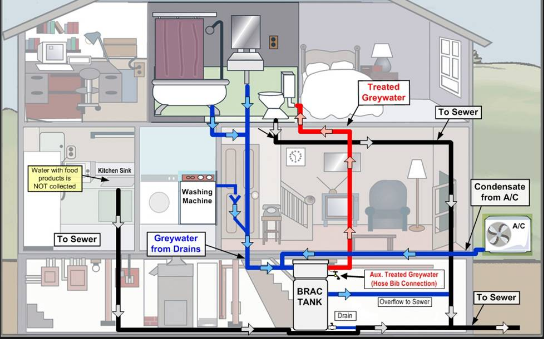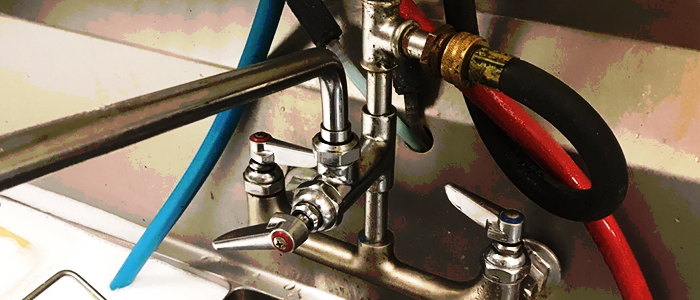A Comprehensive Guide to Your Home's Plumbing System Anatomy
A Comprehensive Guide to Your Home's Plumbing System Anatomy
Blog Article
Every person seems to have their personal opinion about Understanding Your Home's Plumbing Anatomy.

Understanding how your home's plumbing system works is essential for every property owner. From providing clean water for drinking, food preparation, and showering to securely getting rid of wastewater, a properly maintained plumbing system is important for your family members's wellness and comfort. In this extensive guide, we'll explore the elaborate network that makes up your home's plumbing and offer ideas on upkeep, upgrades, and taking care of usual issues.
Introduction
Your home's plumbing system is greater than simply a network of pipelines; it's a complex system that guarantees you have access to tidy water and efficient wastewater removal. Understanding its components and just how they work together can help you avoid expensive repairs and make sure every little thing runs smoothly.
Standard Components of a Pipes System
Pipelines and Tubes
At the heart of your plumbing system are the pipelines and tubes that carry water throughout your home. These can be made of different products such as copper, PVC, or PEX, each with its benefits in regards to durability and cost-effectiveness.
Components: Sinks, Toilets, Showers, and so on.
Components like sinks, bathrooms, showers, and tubs are where water is utilized in your home. Understanding exactly how these components connect to the plumbing system helps in identifying problems and planning upgrades.
Valves and Shut-off Points
Valves regulate the circulation of water in your pipes system. Shut-off valves are important during emergencies or when you require to make repair work, enabling you to isolate parts of the system without disrupting water circulation to the whole home.
Water System System
Main Water Line
The major water line links your home to the municipal water system or a personal well. It's where water enters your home and is distributed to numerous components.
Water Meter and Pressure Regulator
The water meter actions your water usage, while a stress regulatory authority guarantees that water flows at a secure pressure throughout your home's plumbing system, protecting against damage to pipes and components.
Cold Water vs. Warm water Lines
Comprehending the difference in between cold water lines, which supply water straight from the main, and warm water lines, which bring heated water from the hot water heater, aids in troubleshooting and preparing for upgrades.
Drainage System
Drain Pipes Pipeline and Traps
Drain pipelines bring wastewater far from sinks, showers, and toilets to the sewer or sewage-disposal tank. Catches prevent drain gases from entering your home and also catch particles that might create obstructions.
Air flow Pipelines
Ventilation pipes permit air into the drainage system, stopping suction that might slow water drainage and cause traps to vacant. Proper ventilation is crucial for keeping the stability of your plumbing system.
Significance of Appropriate Water Drainage
Making sure proper water drainage stops backups and water damages. Routinely cleaning up drains pipes and maintaining traps can prevent expensive fixings and extend the life of your plumbing system.
Water Heater
Kinds Of Hot Water Heater
Water heaters can be tankless or typical tank-style. Tankless heaters heat water as needed, while storage tanks save heated water for prompt use.
Updating Your Plumbing System
Factors for Upgrading
Updating to water-efficient components or changing old pipes can improve water high quality, lower water bills, and boost the worth of your home.
Modern Plumbing Technologies and Their Advantages
Check out modern technologies like wise leakage detectors, water-saving toilets, and energy-efficient hot water heater that can conserve money and minimize ecological influence.
Expense Factors To Consider and ROI
Calculate the in advance costs versus long-term cost savings when thinking about pipes upgrades. Several upgrades pay for themselves via lowered utility costs and less repair services.
How Water Heaters Attach to the Plumbing System
Comprehending exactly how water heaters link to both the cold water supply and hot water circulation lines assists in identifying concerns like not enough hot water or leaks.
Upkeep Tips for Water Heaters
Routinely flushing your water heater to remove debris, checking the temperature level settings, and inspecting for leakages can prolong its life-span and boost power performance.
Usual Pipes Concerns
Leaks and Their Causes
Leaks can happen because of maturing pipes, loose installations, or high water pressure. Resolving leakages without delay stops water damage and mold growth.
Clogs and Clogs
Obstructions in drains and commodes are commonly brought on by purging non-flushable things or a build-up of oil and hair. Making use of drain displays and bearing in mind what drops your drains pipes can stop clogs.
Signs of Pipes Issues to Watch For
Low tide stress, sluggish drains pipes, foul odors, or unusually high water costs are indicators of possible pipes issues that must be attended to immediately.
Plumbing Upkeep Tips
Normal Assessments and Checks
Schedule yearly pipes inspections to catch issues early. Seek signs of leakages, rust, or mineral buildup in taps and showerheads.
Do It Yourself Upkeep Tasks
Basic tasks like cleansing tap aerators, looking for bathroom leaks making use of dye tablet computers, or insulating revealed pipelines in cold environments can avoid major plumbing concerns.
When to Call an Expert Plumber
Know when a plumbing concern needs specialist experience. Attempting intricate repair work without appropriate knowledge can cause even more damage and greater repair prices.
Tips for Minimizing Water Use
Easy behaviors like taking care of leakages quickly, taking much shorter showers, and running full loads of laundry and meals can preserve water and lower your utility costs.
Eco-Friendly Pipes Options
Take into consideration sustainable pipes materials like bamboo for flooring, which is durable and environment-friendly, or recycled glass for counter tops.
Emergency situation Readiness
Actions to Take During a Plumbing Emergency situation
Know where your shut-off shutoffs lie and exactly how to switch off the water supply in case of a burst pipe or significant leakage.
Importance of Having Emergency Contacts Handy
Maintain get in touch with information for regional plumbing technicians or emergency situation solutions easily offered for quick response during a plumbing crisis.
Ecological Impact and Preservation
Water-Saving Fixtures and Appliances
Setting up low-flow taps, showerheads, and toilets can substantially lower water use without compromising efficiency.
Do It Yourself Emergency Situation Fixes (When Relevant).
Short-lived solutions like making use of air duct tape to spot a leaking pipe or placing a container under a leaking tap can decrease damages up until a specialist plumbing professional gets here.
Conclusion.
Understanding the composition of your home's plumbing system equips you to preserve it successfully, conserving time and money on repairs. By complying with routine upkeep regimens and staying notified about modern-day plumbing technologies, you can guarantee your pipes system runs effectively for years to find.
The Anatomy of Your Home s Plumbing System
Understanding the anatomy of your home s plumbing system is essential for any homeowner. It not only helps in identifying potential issues but also facilitates effective communication with professionals when repairs or upgrades are needed. Your home s plumbing system is more than just pipes and faucets; it s a complex network that ensures the efficient and hygienic flow of water in and out of your house. In this blog, we ll dissect the crucial components of your home s plumbing system. For those in Antelope Valley, Brock Plumbing is your trusted partner for all your plumbing needs, ensuring your system functions smoothly and efficiently.
Water Supply System
Main Water Line: This is where your home s plumbing system begins. The main water line connects your home to the public water supply or a private well. Pipes and Shut-off Valves: Pipes distribute water throughout your home. Shut-off valves are crucial for controlling the flow of water and making repairs without shutting off the entire system. Drainage System
Drain Pipes: These pipes carry waste and water away from sinks, toilets, and showers. Vents: Vents allow sewer gases to escape and help maintain proper pressure in the drainage pipes, ensuring efficient flow of wastewater. Traps: Every fixture has a trap, a U-shaped pipe that holds water and prevents sewer gases from entering your home. The most common is the P-trap under sinks. Fixtures and Appliances
Fixtures and appliances are the most interacted with parts of your plumbing system. They include sinks, toilets, showers, dishwashers, and washing machines. Each fixture and appliance has its own supply and drainage connection, ensuring they receive clean water and can dispose of wastewater effectively.
Water Heating System
Your water heater is a crucial component, providing hot water to various fixtures and appliances in your home. It can be tank-based or tankless, with each type having its own set of advantages and maintenance requirements. Regular maintenance is essential to ensure efficient operation and extend the lifespan of the unit.
Sump Pump
In areas prone to flooding or with high water tables, a sump pump is an essential part of the plumbing system. It s installed in the lowest part of your basement or crawlspace and pumps out water that accumulates, preventing flooding and protecting your home from water damage.
Septic System
Homes that are not connected to a municipal sewer system have a septic system and an underground wastewater treatment structure. Understanding how to maintain your septic system is crucial to prevent backups, odors, and early system failure.
Conclusion
Your home s plumbing system is a complex and essential network, ensuring the efficient and hygienic flow of water in and out of your property. Understanding its key components helps in maintaining it properly and identifying issues before they escalate into major problems. For residents in Antelope Valley, Brock Plumbing is dedicated to providing top-notch services, ensuring that every part of your plumbing system is in perfect working order. Trust our team of professionals to handle all your plumbing needs, ensuring your home remains comfortable, safe, and well-maintained.
https://brockplumbinganddrains.com/blog/the-anatomy-of-your-homes-plumbing-system/

I'm certainly very enthusiastic about Exploring Your Homes Plumbing Anatomy and I really hope you enjoyed reading our blog entry. Don't hesitate to set aside a second to promote this entry if you appreciated it. Thanks a lot for going through it.
Call Today Report this page